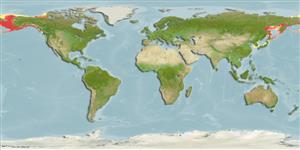Classification / Names
Common names from other countries
Main reference
Size / Weight / Age
Max length : 55.0 cm TL male/unsexed; (Ref. 1371); max. published weight: 1.3 kg (Ref. 56527); max. reported age: 15 years (Ref. 56527)
Length at first maturity
Lm 30.0 range ? - ? cm
Environment
Marine; freshwater; brackish; demersal; amphidromous; depth range 0 - 300 m (Ref. 50550)
Climate / Range
Polar, preferred 5°C (Ref. 107945); 75°N - 30°N, 124°E - 123°W (Ref. 54430)
Distribution
North Pacific: Chemulpo in North Korea (Yellow Sea) in the southwest to Sitka, Alaska in the southeast. Beyond the Bering Strait from Cape Lisburne in Chukchi Sea and east to Dease Strait (south coast of Victoria Island). Precise delimitation of the range depends on additional taxonomic study.
Countries | FAO areas | Ecosystems | Occurrences | Introductions
Short description
Dorsal
spines
(total): 0;
Dorsal
soft rays
(total): 44-59;
Anal
spines: 0;
Anal
soft rays: 39 - 47;
Vertebrae: 57 - 64. Distinguished by the presence of 3 dorsal and 2 anal fins, a lower jaw that is shorter than the upper, a chin barbel that is no longer than half the eye diameter, and a space between the second and third dorsal fins that is equal to or longer than the eye diameter (Ref. 27547). Lateral line curved in front, ending under the second dorsal fin (Ref. 27547); head with no lateral line pores (Ref. 1371). Expanded parapophyses swollen and hollow, beginning on about the vertebral centrum 9 or 10, containing outpouchings of the swim bladder (Ref. 1371). Second pelvic ray produced; caudal truncate or slightly emarginate (Ref. 27547). Grayish brown above, upper part of sides paler, sometimes with a silvery-violet shading, often mottled with indistinct darker blotches; lower sides and belly yellowish to silver white; fins dusky, dorsal and caudal with white edges (Ref. 27547).
IUCN Red List Status (Ref. 115185)
Threat to humans
Harmless
Human uses
Fisheries: highly commercial
Tools
Special reports
Download XML
Internet sources
Estimates of some properties based on models
Phylogenetic diversity index
PD50 = 0.7500 many relatives (e.g. carps) 0.5 - 2.0 few relatives (e.g. lungfishes)
Trophic Level
4.1 ±0.6 se; Based on diet studies.
Resilience
Medium, minimum population doubling time 1.4 - 4.4 years (tm=2-3; Fec=4,900)
Vulnerability
Moderate to high vulnerability (53 of 100)
Price category
